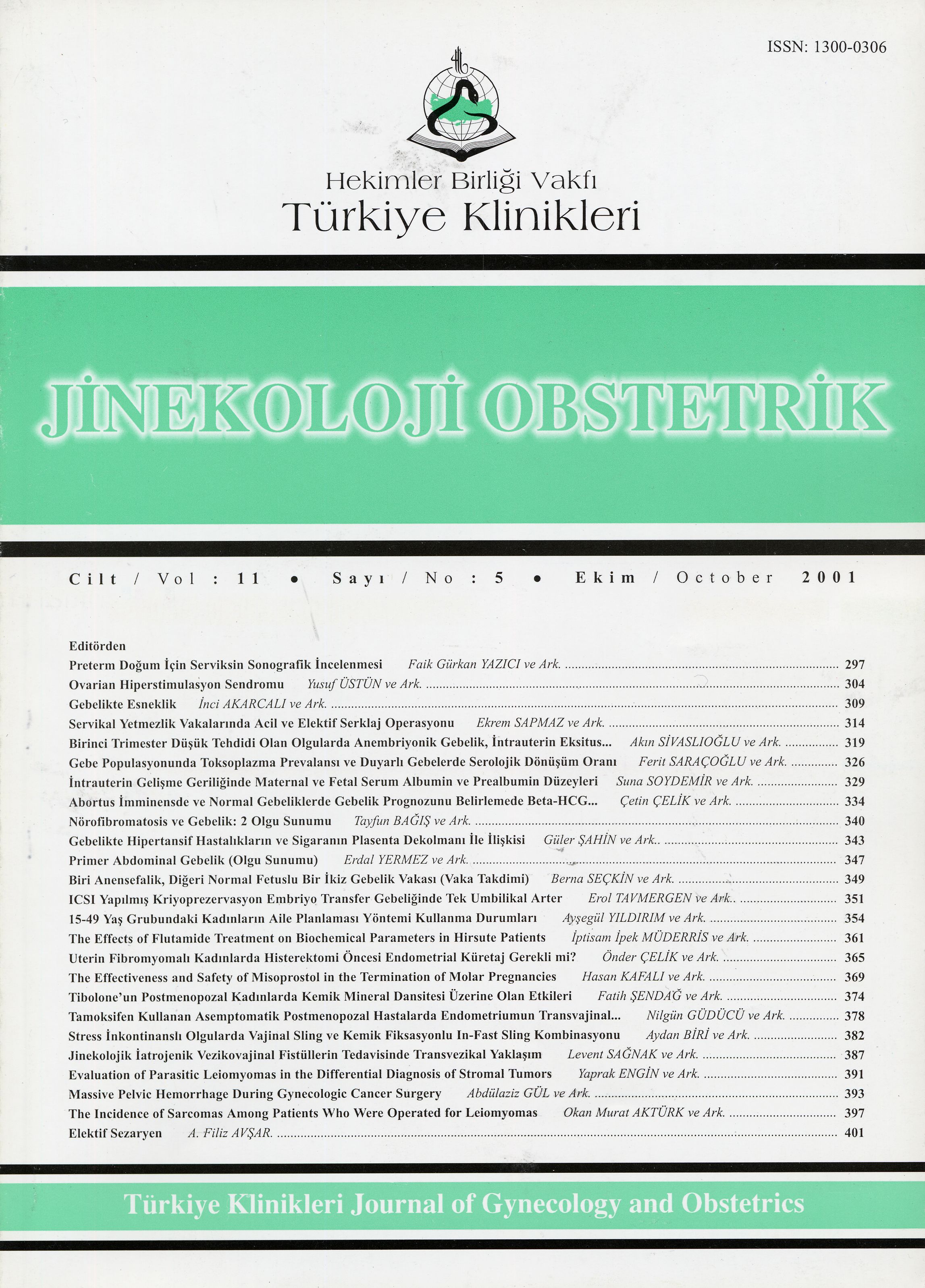Open Access
Peer Reviewed
ARTICLES
3388 Viewed4469 Downloaded
Ovarian Hyperstimulation Syndrome
Ovarian Hiperstimulasyon Sendromu
Turkiye Klinikleri J Gynecol Obst. 2001;11(5):304-8
Article Language: TR
Copyright Ⓒ 2025 by Türkiye Klinikleri. This is an open access article under the CC BY-NC-ND license (http://creativecommons.org/licenses/by-nc-nd/4.0/)
ÖZET
Ovarian hiperstimulasyon sendromu dışarıdan verilen gonadotropinlerle ovulasyon indüksiyonunun tehlikeli ve bazen de hayatı tehdit eden bir komplikasyonudur. Vasküler aralıktan peritoneal, plevral ve daha az oranda da perikardial mesafelere proteinden zengin sıvı geçişi ile karakterizedir. Sendromun yoğunluğu overlerin indükleyici ajanlara verdiği yanıtın derecesiyle ilişkilidir. Patogenezi tam olarak anlaşılamamakla birlikte hCG stimulasyonunun OHSS gelişiminde temel yolu oluşturduğuna inanılmaktadır. İnterstisyel sıvı artışına yol açan ovarian kapiller permeabilite artışında renin-anjiotensin sistemi, vasküler endotelial growth faktör, endotelin-1 ve sitokinlerin rolleri olduğu gösterilmiştir. Klinik olarak hafif, orta, ağır ve kritik form olarak klasifiye edilmekte ve bu da klinisyene değerlendirmede, yönlendirmede ve acil tedavi yaklaşımı konusunda oldukça önemli katkıda bulunmaktadır.
Ovarian hiperstimulasyon sendromu dışarıdan verilen gonadotropinlerle ovulasyon indüksiyonunun tehlikeli ve bazen de hayatı tehdit eden bir komplikasyonudur. Vasküler aralıktan peritoneal, plevral ve daha az oranda da perikardial mesafelere proteinden zengin sıvı geçişi ile karakterizedir. Sendromun yoğunluğu overlerin indükleyici ajanlara verdiği yanıtın derecesiyle ilişkilidir. Patogenezi tam olarak anlaşılamamakla birlikte hCG stimulasyonunun OHSS gelişiminde temel yolu oluşturduğuna inanılmaktadır. İnterstisyel sıvı artışına yol açan ovarian kapiller permeabilite artışında renin-anjiotensin sistemi, vasküler endotelial growth faktör, endotelin-1 ve sitokinlerin rolleri olduğu gösterilmiştir. Klinik olarak hafif, orta, ağır ve kritik form olarak klasifiye edilmekte ve bu da klinisyene değerlendirmede, yönlendirmede ve acil tedavi yaklaşımı konusunda oldukça önemli katkıda bulunmaktadır.
ANAHTAR KELİMELER: Ovarian hiperstimulasyon, ovulasyon indüksiyonu, komplikasyonlar
ABSTRACT
Ovarian hyperstimulation syndrome (OHSS) is a dangerous and sometimes life-threatening complication of ovulation induction with exogenous gonadotropins. It is characterized by massive transudation of protein-rich fluid (mainly albumin) from the vascular space into the peritoneal, pleural and to a lesser extent to the pericardial cavities. The intensity of the syndrome is related to the degree of the follicular response in the ovaries to the ovulation inducing agents. While its pathogenesis is not fully understood , it is believed that human chorionic gonadotropin (hCG) stimulation is important for the development of OHSS. Further evidence suggests that the renin-angiotensin pathway, vascular endothelial growth factor, endotheline-1, and cytokines all play a role in altering ovarian capillary permeability, leading to increased interstitial fluid. Clinical classification into mild, moderate, severe and critical forms of OHSS can help the physician to plan appropriate investigations, admission requirements, and acute management.
Ovarian hyperstimulation syndrome (OHSS) is a dangerous and sometimes life-threatening complication of ovulation induction with exogenous gonadotropins. It is characterized by massive transudation of protein-rich fluid (mainly albumin) from the vascular space into the peritoneal, pleural and to a lesser extent to the pericardial cavities. The intensity of the syndrome is related to the degree of the follicular response in the ovaries to the ovulation inducing agents. While its pathogenesis is not fully understood , it is believed that human chorionic gonadotropin (hCG) stimulation is important for the development of OHSS. Further evidence suggests that the renin-angiotensin pathway, vascular endothelial growth factor, endotheline-1, and cytokines all play a role in altering ovarian capillary permeability, leading to increased interstitial fluid. Clinical classification into mild, moderate, severe and critical forms of OHSS can help the physician to plan appropriate investigations, admission requirements, and acute management.
MENU
POPULAR ARTICLES
MOST DOWNLOADED ARTICLES





This journal is licensed under a Creative Commons Attribution-NonCommercial-NoDerivatives 4.0 International License.










